
How do great artists create such beautiful paintings?
Brushstrokes & Painting Effects
Learn the techniques you need to actually paint.
ONLINE Painting Course Returns in a few months
ONLINE Painting Course Returns in a few months
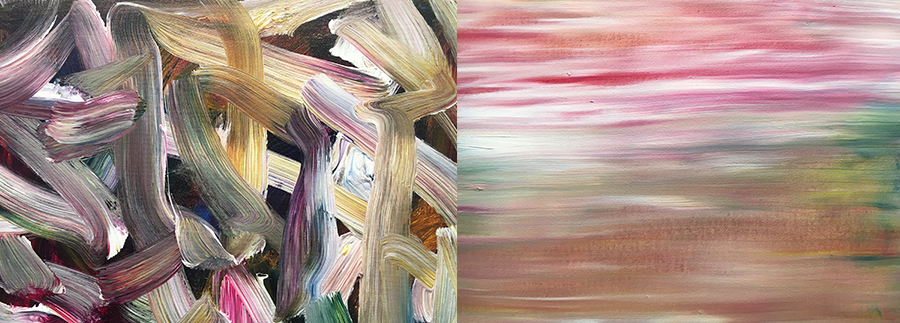
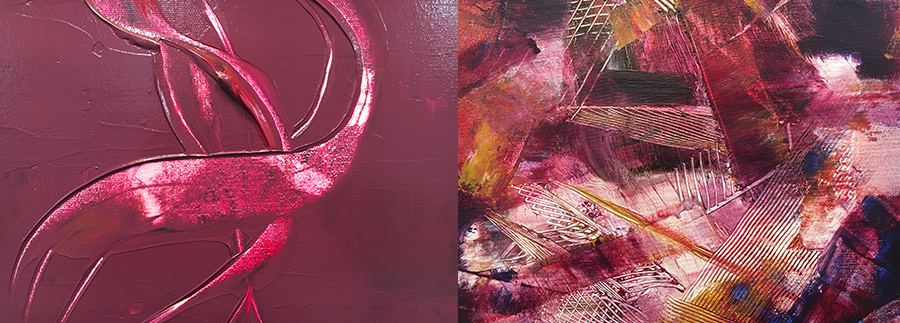
All of the images on this page are painting effects I’ve created for this course. The two at the top use the technique "wet on wet" where the colours are mixed by overlaying strokes on top of each other. The bottom two are examples of sgraffito which means scratching through the paint surface with different tools. Paintings by Gareth Bate.
What does it take to make great looking brushstrokes rather than messy blobs? How do you get them to transform into something?
What's the deal with all those brushes in the store? Why are there so many!? What size? Palette knives? Ahhh!
What are all those jars and bottles of mediums? They all look the same! What do they even do?
How do you get the paint to do interesting things? How do you actually paint?
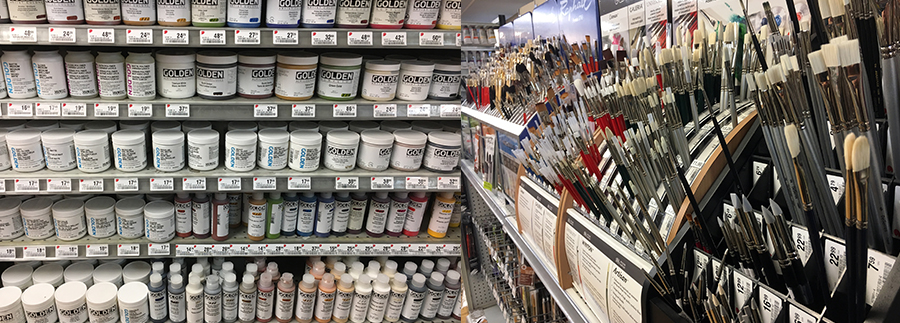
Ahhhh!!! What are all these things??? .
If you've felt this frustration and confusion. You're in the right place.
Shhh! I'll let you in on a secret.
I have a brushstroke fetish!
I have a bit of a thing for photographing close-ups of paintings.
Guards don’t like it! I've photographed in museums on three continents. I go right up and zoom in on the brushstrokes to figure out how the paintings were made. Something that's fascinating is that up close, paintings are frequently covered in messy vigorous brush effects that look totally different when you move back. Stepping back, they suddenly transform into abstract effects or recognizable things. It's surprising.
Artists develop their own approach over years of working in the studio. In my six years of post-secondary art education I never had a class where anyone showed me how to do these painting techniques we cover. You don’t get this anywhere else. It’s all stuff I've taught myself to do over 25 years of painting. There's a lot more to it than you might think.
But here's the thing - it's totally learnable. No one pops out knowing how to do this.
Every painting detail on this page I created for this course. I've taught myself to do a massive range of techniques. Now I can share them with you.
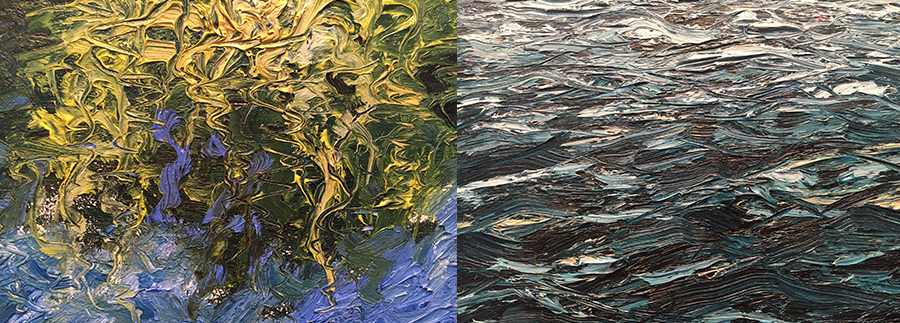
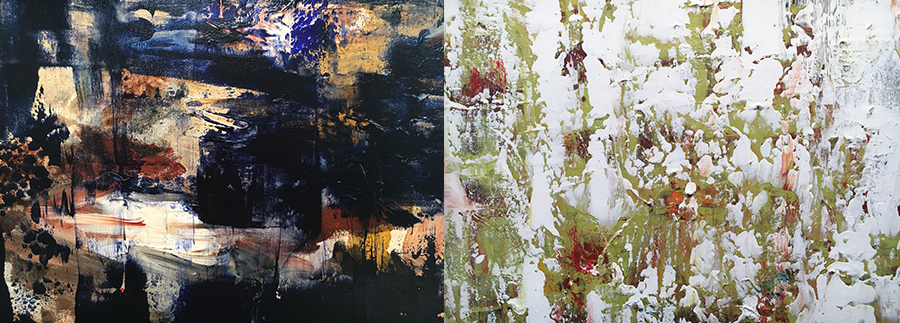
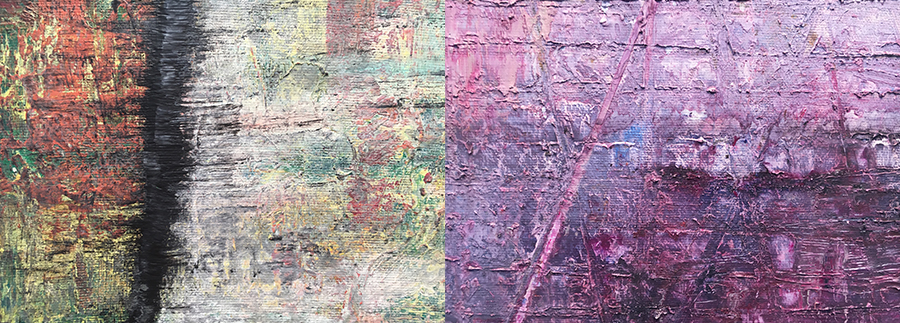
The top paintings are wet on wet in oil paint. The bottom four are acrylic constructed using layers of wet paint over dry. Paintings by Gareth Bate. .
No one teaches you this in any comprehensive way...
Until now!
Brushstrokes & Painting Effects is part of my four course Technical Painting Series. This course is for acrylic and oil painters. Unfortunately, watercolour doesn't work as it requires totally different methods (perhaps later).
It doesn't matter if your paintings are realistic or abstract, landscapes or portraits, every one who paints needs to know how to properly apply the paint. Understanding painting techniques makes you a better painter.
This course is about developing a huge range of methods so that you can draw on them later whenever you need them. I'm not a believer in "finding a style" and sticking to it. I think a painter needs to have lots of skills, techniques, and colour ranges so you can use whatever is necessary to communicate in the clearest way possible.
The medium is the message!
It's time to end the frustration. This is very doable.
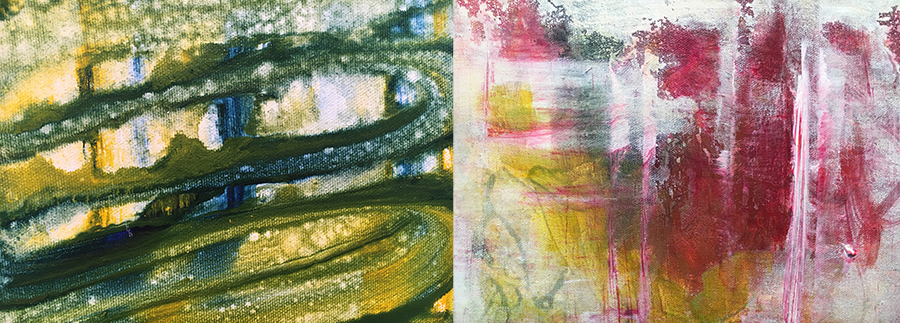
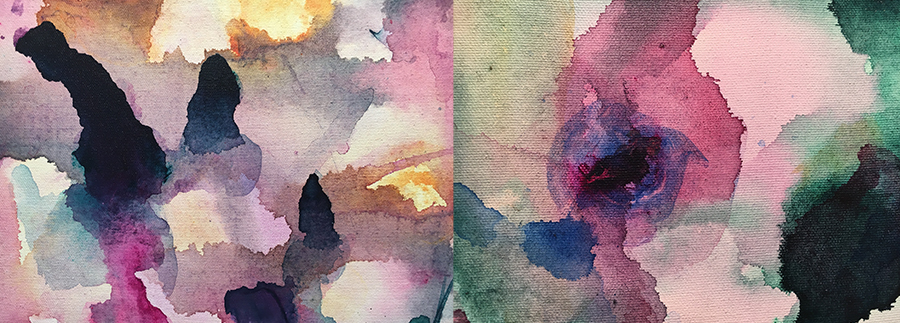
These painting details are washes where you break the paint down with water in acrylic or mineral spirits in oil. A bit like the look of watercolour. When you paint thin the challenge is how do you achieve good paint quality. Paintings by Gareth Bate.
In this course you'll learn a huge variety of techniques such as:
Gestures: The way you hold the brushes and knives, and the way you move your fingers, hand, arm and whole body is a massive factor in painting that no one trains you to do.
Brushes and Knives: There's so many. But you’ll learn the basic categories and why you would need them. You'll learn about the differences and when to switch brushes. They come in different lengths, sizes, textures and shapes.
Mediums: These are added to the paint to change the texture and alter the way the paint moves. There's so many. You'll learn about the ones that matter and ignore the ones that don’t.
Paint Quality: One of the most fundamental and elusive aspects of painting is “Good Paint Quality”. Does the paint actually look good? How do you achieve that?
Wet on wet: Applying the paint directly into another brushstroke while both are wet so the colours mix right there on the painting.
Blending: Making a smooth and seamless gradient from one tone to another.
Layering: Building levels of paint where you see the history of effects accumulating over time. (This is the most important one.)
Dry-Brushing: Applying small quantities of paint to a dry textured surface. This creates a layered mottled effect.
Impasto and Thick Texture: Building thick gooey brushstrokes with a rough brush or a knife. This involves using mediums.
Sgraffito: Scratching into the paint surface.
Washes and Thin Paint: Washy effects means thinning the paint down. It can look beautiful or really crappy depending on how well you do them.
Sharp Lines & Hard Edges: How do you get crisp sharp lines and edges?
Glazing: Thin layers of translucent colour applied layer by layer creates a beautiful glowing effect. Because it’s see-through it can also be used to make subtle improvements to your painting without losing the great stuff you’ve already done.
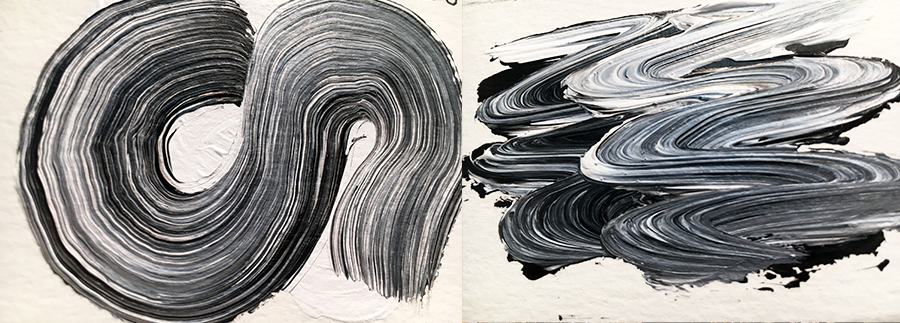
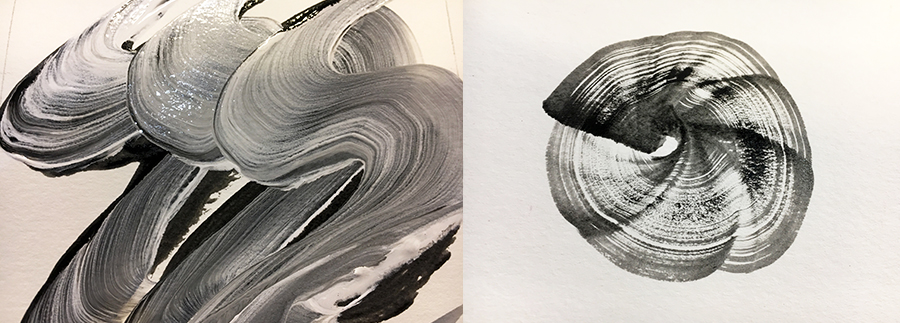
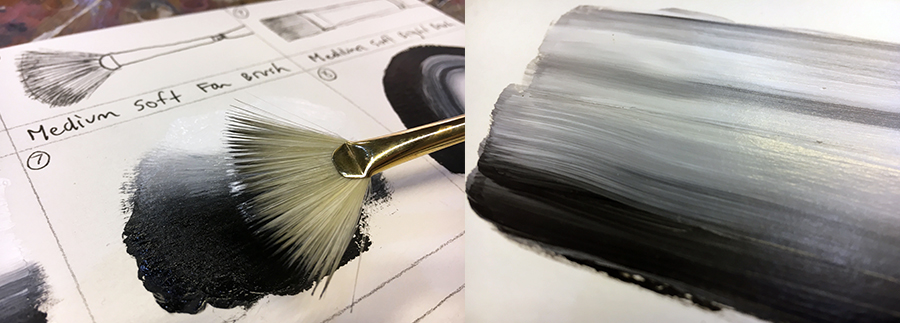
Above are some examples of the black and white brushstrokes charts you'll be doing in this course. The top ones are "wet on wet", the middle ones are "washes" and the bottom ones are "blending".
Art Untangled
I created Art Untangled to teach one-of-a-kind courses that you can't find anywhere else. These courses get right to the heart of the painting problems you face. Rather than learn everything at once I break it down into courses that focus intensely on a single issue like colour mixing, painting techniques or colour relationships, etc. They're about putting in the work over a relatively short period of time so that you can save YEARS of struggle. There’s a lot to learn in painting and drawing but it doesn't need to take you decades if you learn it well from the start with the right teacher.
Here's How the Online Course Works
For the last two years I’ve been systematically building my online art school - Art Untangled. Because of the Covid-19 crisis I cancelled all my in-person courses and am going exclusively online for the foreseeable future. I don’t anticipate this social distancing and quarantining ending any time soon. But I intend to keep teaching and learning during this time. I hope you will keep learning too.
I know that these are stressful and anxiety inducing times for all of us. We don’t need more pressure and things change from day to day. For that reason I have divided this course into two parts. This is because I have already completed all the online content for Part 1, but I have not finished the online content for Part 2. When you sign up you will be invoiced for Part 1 only. If I’m then able to complete Part 2 you can opt-in for that part down the road and pay then. Or you could choose to opt-out if it’s not the right time for you. I think we all need some flexibility right now.
Part 1 - Now
BRUSHSTROKES CHART SYSTEM: I've wandered around museums in different countries and photographed details from paintings. I then organized them into categories and realized that when you look up-close the artists are often doing the same effects even when the imagery is totally different. So a modern or abstract painting might actually have similar methods to a representational one. That was surprising! In some ways the imagery changes radically but the painting methods don’t. So I’ve invented a series of Black and White charts to teach you a huge range of different brushstrokes and painting effects.
For Part 1 they're entirely in Black and White so that you don't have to worry about colour mixing and can focus exclusively on the strokes and techniques. My in-person students did these charts as homework each week. So there’s no difference between what you’ll do and what they did. It’s delivered in detailed pdf instruction manuals that I’ll send to you via email. You'll need to read and follow the instructions. These are clearly written with tons of pictures. You can print them out if you have access to a printer or just work from your screen or phone. You will only need the paint colours Titanium White, Mars Black or a different black - or umbers if you can’t get it. You’ll need heavy paper or a canvas pad. But you will require specific kinds of brushes and knives.
WHO CARES PAINTING: So you’ve completed the charts. Now try applying the techniques you’ve learned to a little “Who Cares Painting”. These can be in full colour - You whatever you have. This often turns into something interesting because you're not trying to make art. Who cares! You're just messing around and playing. I highly encourage you to apply the techniques to your own little paintings.
Part 1 Themes
Pre-Course Free Bonus Assignment: Techniques Museum Tour and Assignment 1 in advance - You can start as soon you're confirmed! Assignment 1: Wet on Wet Assignment 2: Flat Washes Assignment 3: Mop Washes Assignment 4: Layering: Dry Brush Assignment 5: Brushes and Knives Bento Box Assignment 6: Thick Texture and Knife Effects Assignment 7: Blending Assignment 9: Sharp Edges Assignment 10: Layering: Wet Over Dry
Part 2 - Later
This part of the course I’m currently unable to deliver until I can complete it. But I’m working on it! So you will not be charged for this portion until I’m able to deliver it. I will invoice it separately - later. You can choose to opt-out if it’s not the right time.
COPYING PAINTING DETAILS: All the images on this info page are me creating paintings using a ton of different techniques I observed in famous artworks. You’ll be analyzing the construction of my painting details and then creating copies of them where you try to solve the mystery of their creation. How was the paint applied? In what order were the levels created? You’ll use your charts from Part 1 as your guide. I will then teach you how to understand the paintings so you can look at any painting and figure out how it was made. I'm a big believer in copying as a great way to learn and expand your range. It forces you to look deeply and to attempt to do things you're not naturally inclined to do. I’ve noticed a huge boost in confidence among the students who have taken this course. This will give you lots of experience trying to recreate all sorts of effects. Part 2 will require a full range of specific paint colours and mediums.
LIFE-LONG REFERENCE BOOK: At the end of the course you'll pull all your work together into a beautiful portfolio sleeve book. You'll have a comprehensive manual of all kinds of paintings effects, gestures and brush techniques you can refer to for years to come.
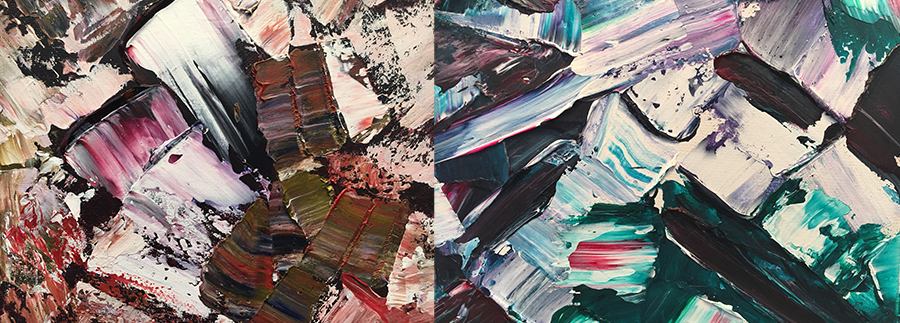
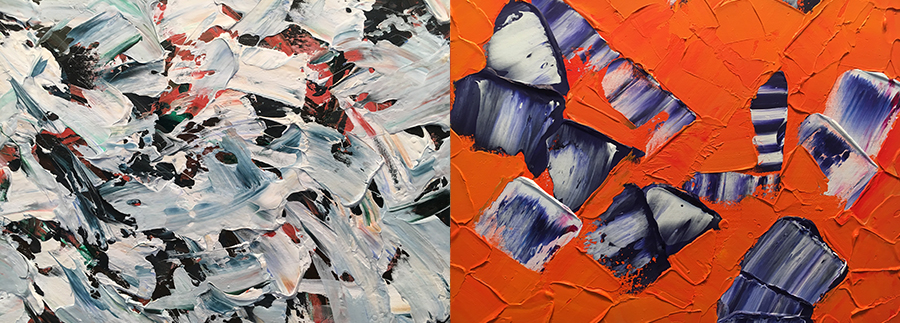
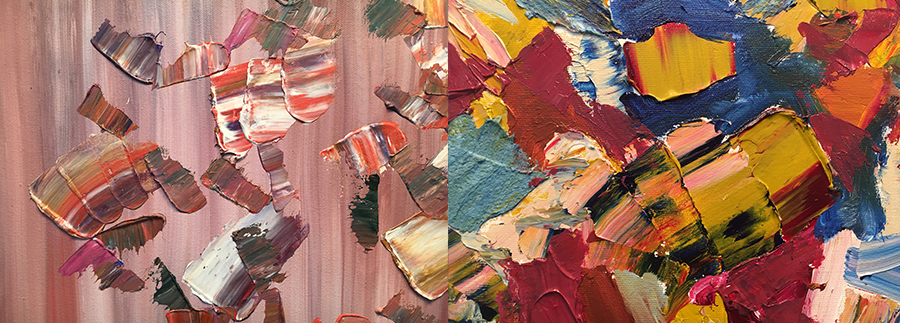
All of these paintings use thick texture and knife effects. In acrylic you have to use mediums mixed with the paint to do this. There’s also mediums to thicken oil paint. But which ones? Paintings by Gareth Bate.
When you learn to apply the paint you learn to paint.
Let's be clear - this course requires discipline. It's a lot of work.
You need to have the right mindset. This is about doing the hard stuff that most people never bother to do. You'll be taking your paintings to the next level.
ART SUPPLIES
Here are the pdf guides to the materials you need to get.
You choose to work in either acrylic or oil. I understand that sourcing art supplies right now is a challenge. Note the “other materials pdf”. Consider it your first free lesson about art supplies.
I’ve been working on contacting art supply stores and suppliers directly. I’ve created a supply list that you can order directly to ensure that you get exactly the right materials. I’ve done as much work for you as a I can.
Given the circumstances, you may find that you can get a lot of the brushes and mediums but you are missing a few of them. Or some are delayed. If this is the case just skip those on the charts and do the ones you are able to do. Return to them later. We are all trying to adapt and make it work. Ultimately, you will have the charts, so you can do them when you can are able.
FEEDBACK
I will set up a private Facebook group where you can post your charts as you finish them. You’ll be able to interact with the other students going through the course. I will pop in from time to time and give feedback about your charts and “who cares paintings” during the run of the course via the facebook group. The Facebook aspect is an important part of the course and enhances the experience. I know Facebook is unpopular with a lot of people, (myself included). Right now it’s the easiest way to make this happen. You can choose to opt-out of this aspect and just receive the course materials. But the feedback I'll be giving will take place in that Facebook group. You could make a fake profile and just join the group. Most of part 1 is straight forward so it doesn't require a ton of feedback from me. You are just following the instructions in the pdfs. But I will only be doing group feedback via the Facebook group. You could make a fake profile if you don't want to join as yourself.
Advantages of Online Learning
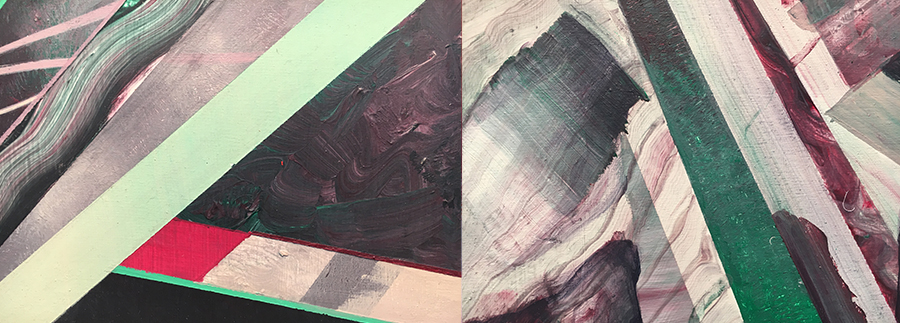
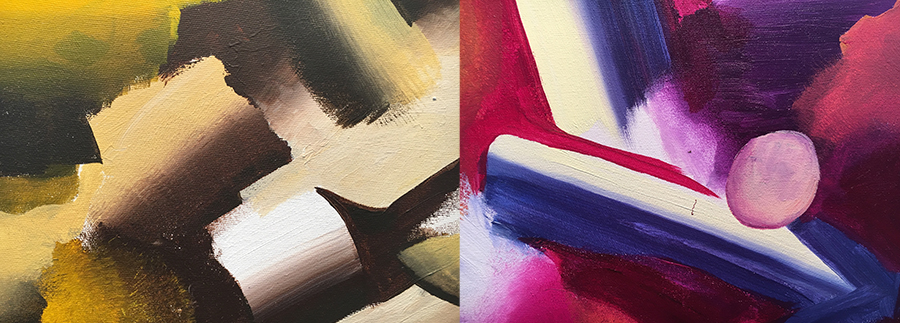
The top two paintings use blending to create different gradients. I used soft brushes including the challenging fan brush. Below I’m working with sharp edges. But how did I keep it so clean and sharp? Paintings by Gareth Bate.
Art Untangled
Brushstrokes & Painting Effects
Learn the techniques you need to actually paint.
DETAILS
Registration: In a few months
Course Location: ONLINE ONLY
Instructor: Gareth Bate
My Location Toronto, Ontario, Canada
Duration: Part 1: 10 Weeks + Bonus Pre-Class Assignment
Registration Starts: In a few monthsRegistration Deadline: TBA
Price and Registration Info at the bottom of this page.
Please sign up right away rather than waiting so I can send you your materials list:
IMPORTANT: Your painting supplies are not included.
DATES for Part 1
The course is delivered online with each new assignment arriving on Monday mornings. There is no live component so the work can be done at any time.
Pre-Course Free Bonus Assignment: Techniques Museum Tour in advance - So you can start as soon you're confirmed if you want! Week 1: TBA Week 2: TBA Week 3: TBA Week 4: TBA Week 5: TBA Week 6: TBA Week 7: TBA Week 8: TBA Catch Up Week: TBA Week 9: TBA Week 10: TBA
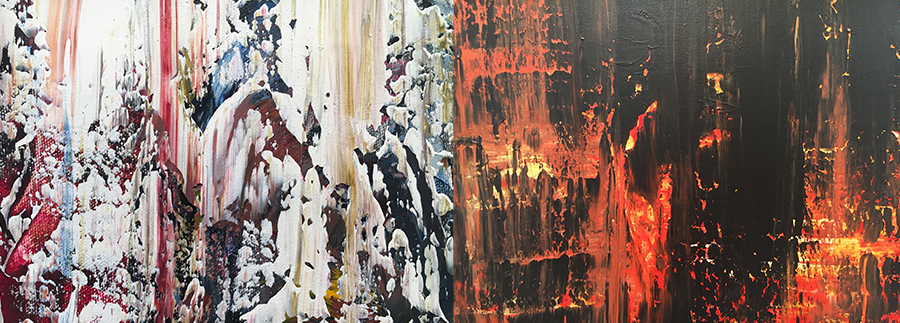
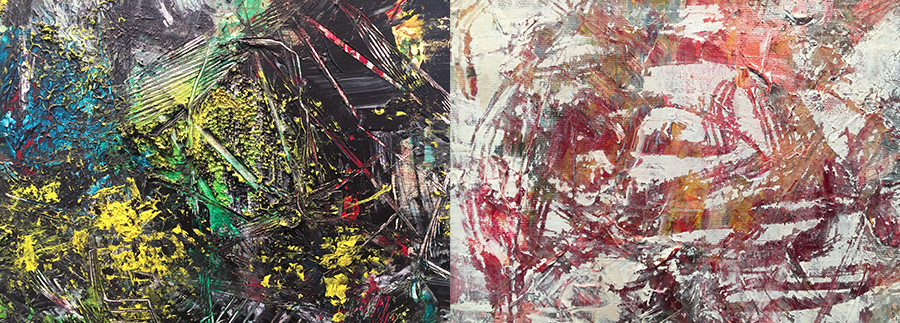
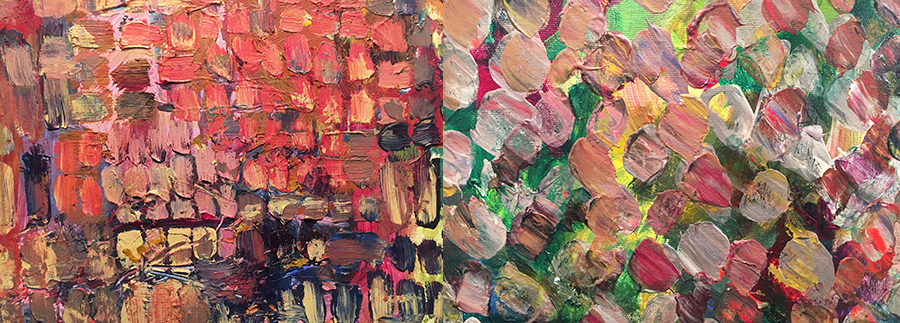
All of these paintings are constructed using layering. But what did I use? Paintings by Gareth Bate.
Dates don't work for you?
If you're interested in this course but these dates don't work for you be sure to subscribe to my newsletter so you get updates from me about future online courses. Shoot me an email to let me know that you're interested. contact@garethbate.com
SPECIAL OFFER:
You can SAVE $25 off your course price if you sign up a friend who hasn't taken my private courses in the past. I take $25 off for each person you sign up.
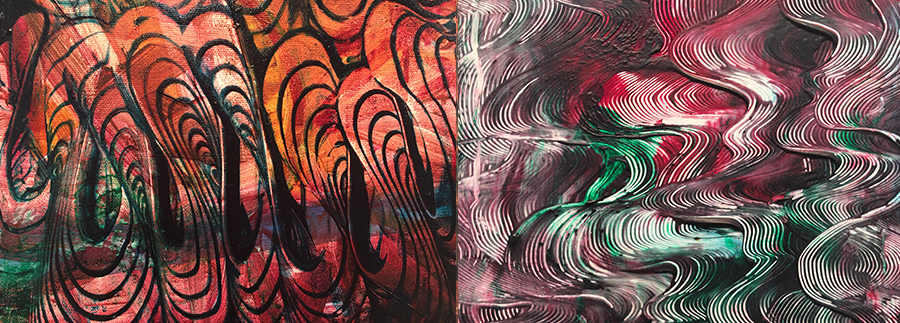
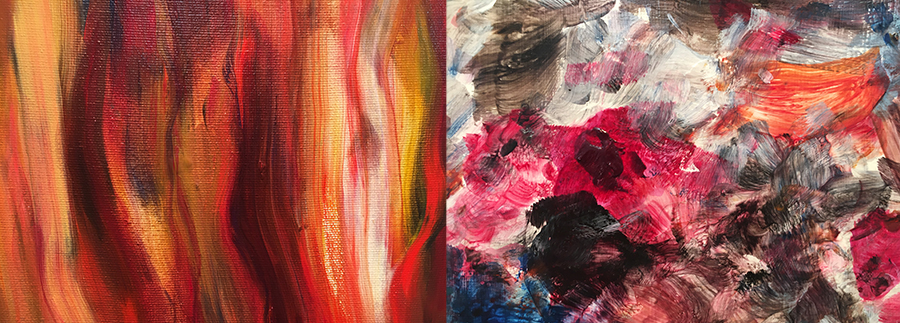
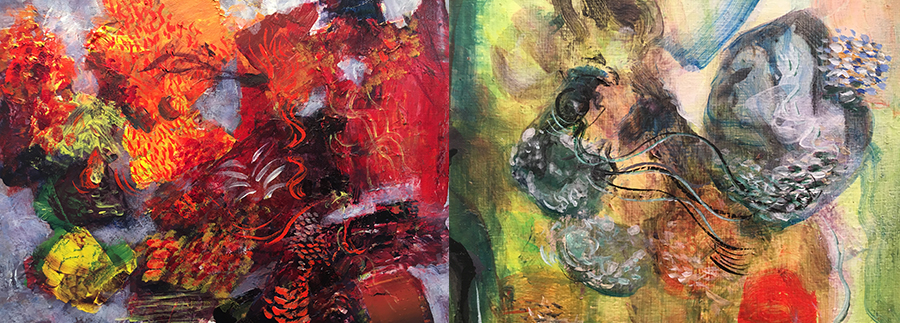
In the paintings above I’m using glazing to make translucent layers. In the ones below I’m building layers and then using tiny brushes to create details. Paintings by Gareth Bate.
Course: Frequently Asked Questions
Is this for Abstract or Representational painting?
Both. The same techniques can be used to create different imagery. It’s all about how you apply the methods to your own work.
I previous did some techniques workshops and intro to painting classes. How will this be any different?
In six years of art education I never had anything remotely like this course. I had really basic instruction on a few of these methods. So I invented this course based on what I wish I'd learned as a student. This would have made painting much easier. It would have saved me years of trial and error. This goes way beyond a regular intro to painting class.
I'm worried this might be too hard for me. Will I be able to do it?
You gotta start somewhere. This is the reality of painting. My feeling is learn technical skills when you're ready for them. It's not about making masterpieces.
I'm a total beginnner. I've never painted. Is this appropriate for me if I'm new to painting?
Depends on what you're looking for. This is part of my technical painting series. I have three courses devoted entirely to colour. The Colour Mixing Detective and the advanced course are about understanding paint on a deep level and learning to mix a massive range of colours. Colour Stories and Relationships (not online yet) is all about understanding colour schemes and the stories they tell in your paintings. This course is about applying the paint. So I won't be addressing colour at all in this course. Beginners can do this course. I don't think this is the best way to start for every person new to painting. It’s very technical. You need to ask yourself a few questions.
To me there are two types of art students. One likes to leap right in creating paintings and the main motivation is creativity and self-expression. This type is better off doing some paintings and then acquiring technical skills along the way when you realize you need them. The other type likes to have a technical foundation in order to feel comfortable starting to paint. They want some assurance of competence with the materials before launching in to the creative part. If you’re the first type you’re better off taking my online course My Inbox Art Project. If you’re the second type then this class works perfectly. If you’re unsure, email me and we can talk.
This sounds like a lot of work, I’m a little intimidated…
My classes are for real and designed to master the subject matter. They’re one-of-a-kind and intensive.
Can I do multiple courses at once?
Normally I would say no. But I've made these online courses into two parts. That means you could do The Colour Mixing Detective or My Inbox Art Project at the same time as this one if you want. There's no escaping colour mixing. The Colour Mixing Detective takes a lot of time.
Can I do this course with a friend or family member?
You can both sign up individually. Both would be required to pay. I ask you not to share this with people who have not paid. All the course materials are proprietary and I’ve spent a massive amount of time developing them. I appreciate your honesty in this regard.
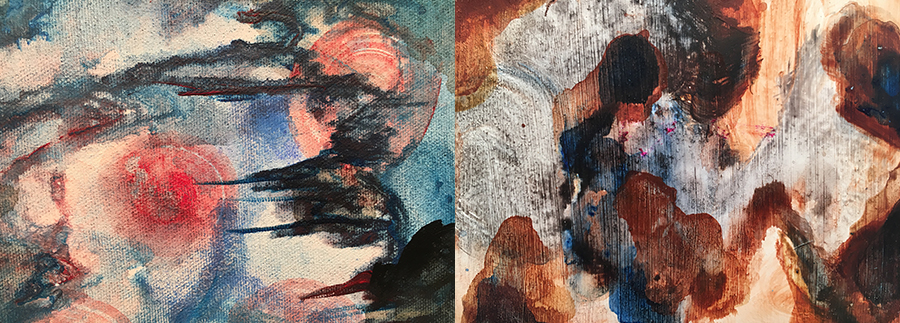
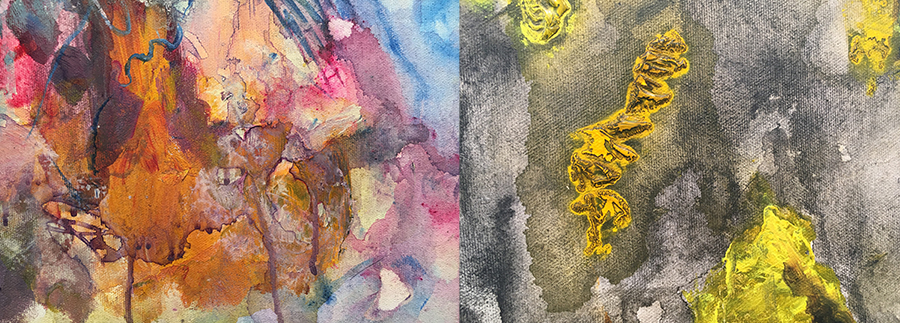
The paintings above use washes which means breaking the paint down using water in acrylics and mineral spirits in oils. Paintings by Gareth Bate.
Materials: Frequently Asked Questions
I'm unsure about this course because of the cost of the course and materials. Do we really need all these brushes and mediums?
For Part 1 you don't need the full range of materials. You only need Titanium White and Mars Black and the brushes and knives. If you have other colours that great. For Part 2 there are specific colours you'll need to get. But we are not there yet. I totally understand the concern about the cost of materials. I have the same experience every time I go to the art supply store! Making art in not cheap. You won't regret buying these brushes and mediums. You'll be learning to actually use them. They will be the foundation of your art practice from this point forward. For Part 2 I've selected colours that allow you to mix nearly every colour you'll encounter. These are foundational.
What brands of paint should I use?
I think you should always use artist quality paints from day one. One of the biggest issues students have with painting is using crappy student paints. By starting with professional paints you learn to paint once rather than having to learn twice when you end up switching. Good paint makes good paintings. For acrylic I'd say Golden. Every student ends up switching to Golden, so I'd start there. For Oil I'd say Gamblin, Williamsburg or Grumbacher.
What medium should I use?
Overall use the medium you most want to work in for the long term. Which one is most exciting to you? Which one feels like the right choice under the circumstances?
Acrylic: Most students start work in acrylic as it's easier to deal with and dries fast. It has a lot of advantages but also disadvantages - like drying fast. The key to acrylics is adding mediums. Without them it’s not great. Acrylic is not safer than oil.
Oil: Working in oil is great. It’s beautiful and keeps all it’s brushstrokes. But the clean up is a pain and it takes several days to dry. You need to have a well ventilated space if you use oils and odourless mineral spirits. Don’t use Turpentine. Water mixable oils are also fine.
Can I paint in watercolour?
Unfortunately no. This course is just for acrylic and oil painting. Watercolour is a totally different thing. I'd have to come up with different technical methods for that. Perhaps in the future I'll do a watercolour specific version. Be sure to subscribe to hear about it.
Unsure if this is for you?
Shoot me an email and we can chat about it. contact@garethbate.com
Ready? Continue on to join us!
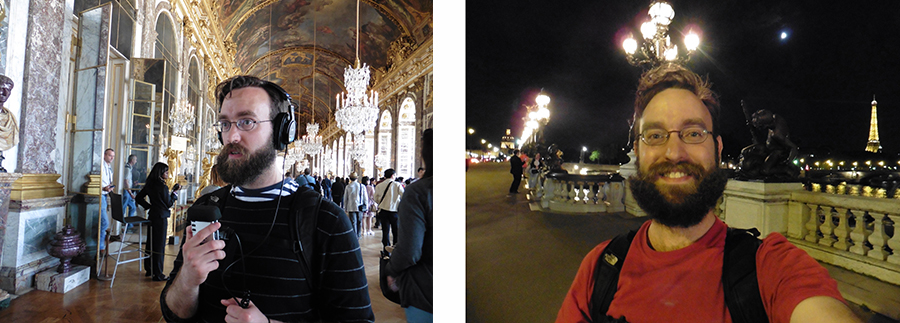
About Me
My name is Gareth Bate and I’m a full time artist, curator and art teacher living in Toronto. I work in painting, installation and photography. I have an education company Art Untangled and an email newsletter where I talk about art on a regular basis. You can subscribe here. I've been asked if everything I do revolves around art and the answer is pretty much yes!
I've travelled extensively and visited all the major museums in London, Paris, New York, Washington DC, Boston, Montreal and Cape Town. I'm Festival Curator of the World of Threads Festival an international festival of contemporary fibre and textile art in Oakville. I graduated with a BFA from OCAD University and a diploma from Central Tech's adult art program. I've been teaching since 2008. I’ve been featured on CBC News and Radio Canada and in the Globe and Mail, Toronto Star, Now Magazine and La Presse among others.
Here are the ONLINE courses I teach: The Colour Mixing Detective Part 1 The Colour Mixing Detective Chief Inspector (Advanced) Brushstrokes and Painting Effects Part 1 My Inbox Art Project: Home Edition
So it’s time to make a decision.
You can continue to struggle with your paintings...
Or you can join us and learn to create beautiful exciting painting effects.
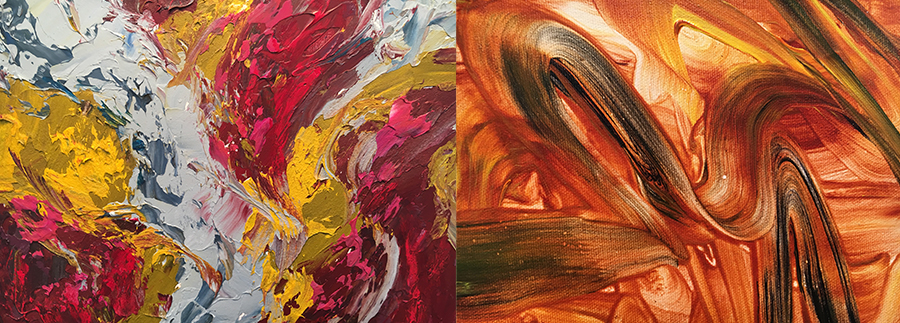
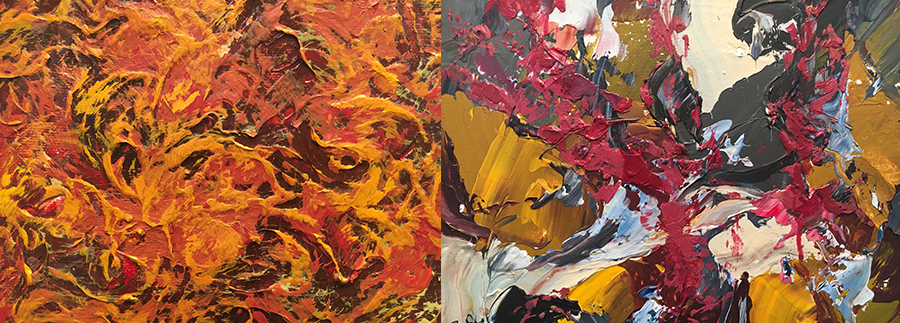
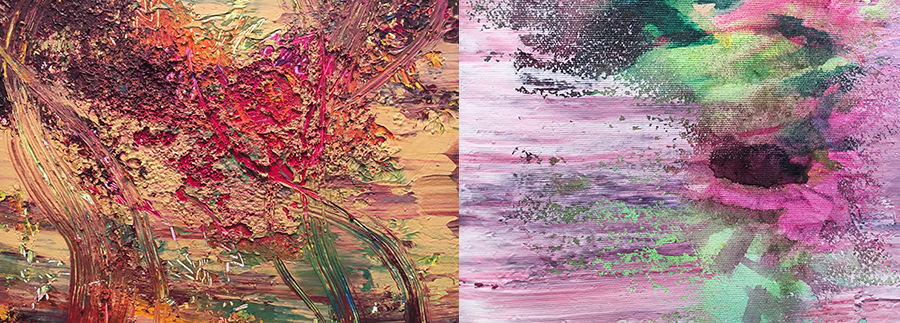
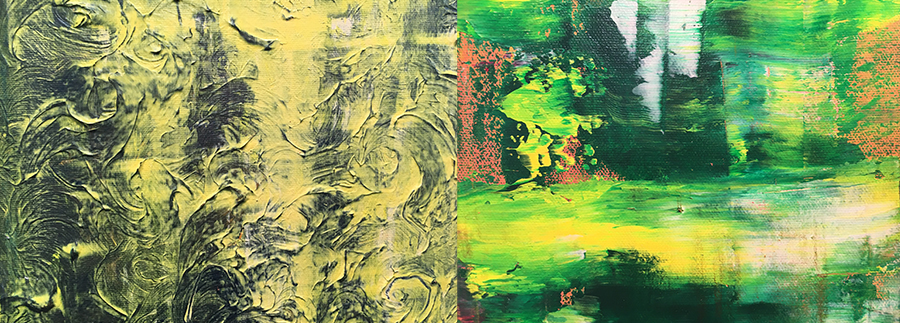
The paintings at the top are wet on wet, and the ones below are layering. Paintings by Gareth Bate.
Register Now to
Reserve Your Spot!
Registration
PART 1 COST: $400 - Now
PART 2 COST: $400 - Later
+TAX for Canadians depending on region
SPECIAL OFFER:
You can SAVE $25 off your course price if you sign up a friend who hasn't taken my private courses in the past.
How to Pay
When you book I'll send you an invoice. You can then send me an online e-transfer or cheques in Canada. Payment is required to be sent within two days of receiving the invoice. There is tax for Canadians. As soon as I've received payment I will start to send you course materials.
When you sign up you will be invoiced for Part 1 only. If I’m then able to complete Part 2 you can opt-in for that part down the road and pay then. Or you could choose to opt-out if it’s not the right time for you.
Refunds Policy
I'm 100% confident in the value of this course. Therefore, I don't offer refunds. It's important to commit to taking the class. I offer a lot of information on this page to help you make a decision. If you're unsure, send me an email and we can talk about it.
Here's how to register...
Send me an email: contact@garethbate.com
Subject Line: Registration for Online Brushstrokes and Painting Effects ONLINE
What to include:
Full Name
Your Pronouns
Your Email
Phone Number (so I can communicate with you if necessary)
Full Address:
What medium do you plan to work in?
Payment Policy: Payment is required on registration within 2 days of receiving your invoice.
Payment Method: Online: e-transfer or cheque for Canadians.
Do you plan to get your art supplies from stores, online or a mix of both?
How did you hear about the course?
What happens next?
After you register I’ll confirm in an email and then send you an invoice. After payment is received I’ll send full course info and pdfs of the art supply list.
Still Got Questions?
Send me an email: contact@garethbate.com
I'm looking forward to it!
Please share my courses with anyone you know who might be interested. Thanks!
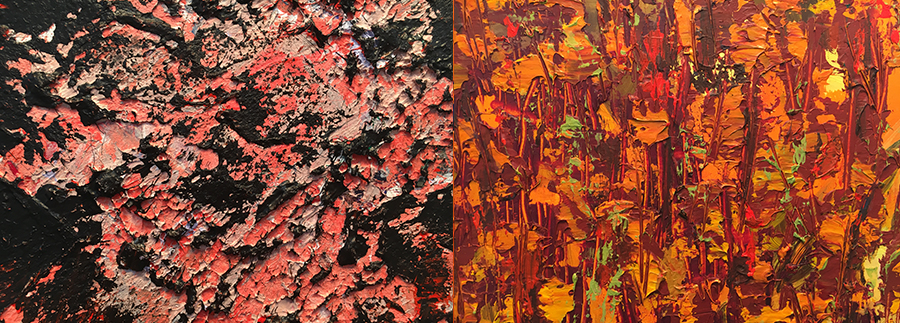
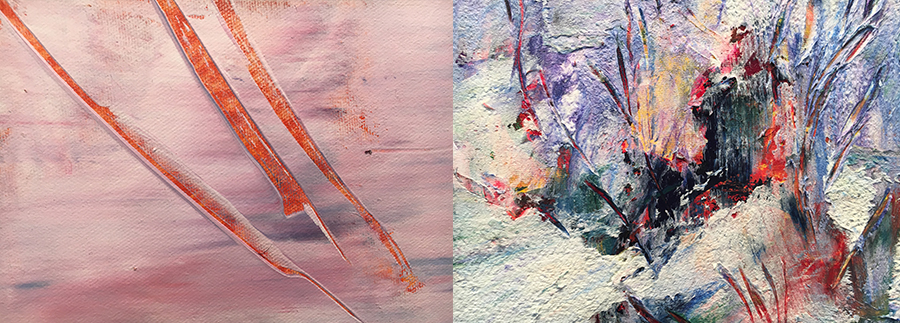
Paintings by Gareth Bate.